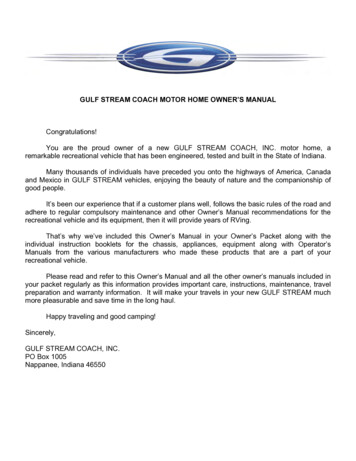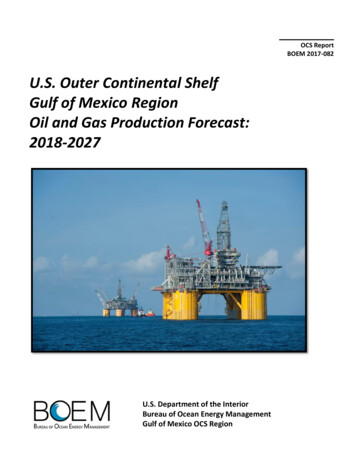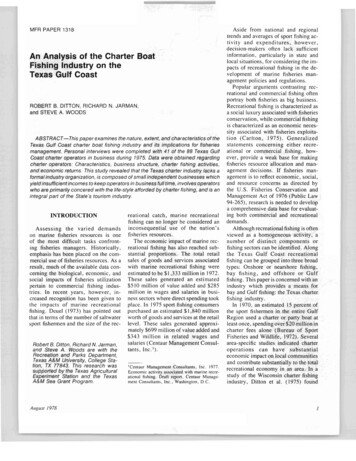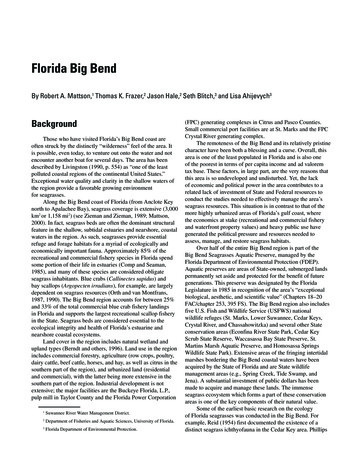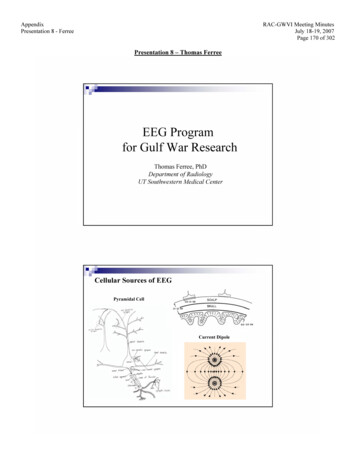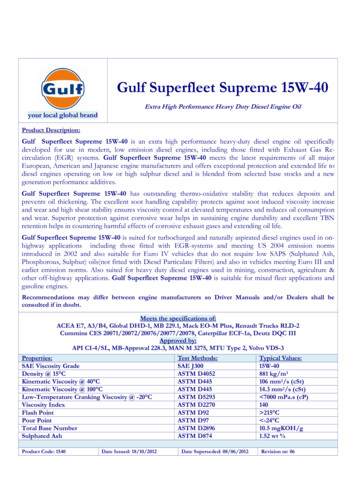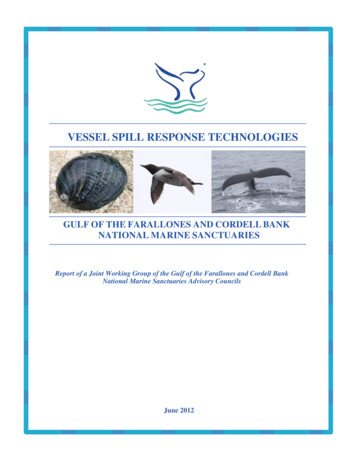
Transcription
VESSEL SPILL RESPONSE TECHNOLOGIESGULF OF THE FARALLONES AND CORDELL BANKNATIONAL MARINE SANCTUARIESReport of a Joint Working Group of the Gulf of the Farallones and Cordell BankNational Marine Sanctuaries Advisory CouncilsJune 2012
We would like to thank:PRBO Conservation Science for supporting the working group's meetingsand the institutions, agencies, and organizations that supported their staffand representatives in participating.iii
Working Group MembersYvonne Addassi, Office of Spill Prevention and Response, CA Dept. of Fish and GameSarah Allen, Ocean Stewardship Program, National Park ServiceRichard Charter, Ocean Foundation; GFNMS Advisory CouncilBarbara Emley, San Francisco Community Fishing Association; GFNMS Advisory CouncilEllen Faurot-Daniels, Office of Spill Prevention and Response, CA Dept. of Fish and GameJaime Jahncke (Chair), PRBO Conservation Science; GFNMS and CBNMS Adv. CouncilsGerry McChesney, Farallon National Wildlife Refuge, US Fish and Wildlife ServiceRenee McKinnon, US Coast Guard - Sector San Francisco (June 2011- February 2012)James Nunez, US Coast Guard - Sector San Francisco (March 2012 - June 2012)Patrick Rutten (Chair), NOAA Restoration Center; GFNMS Advisory CouncilDeb Self, San Francisco Baykeeper (June 2011- February 2012)Jordan Stout, Office of Response and Restoration, NOAABob Wilson, Farallones Marine Sanctuary Association; Marine Mammal Center;GFNMS Advisory CouncilIan Wren, San Francisco Baykeeper (March 2012 - June 2012)Invited Agency ObserversLeslie Abramson, Gulf of the Farallones National Marine Sanctuary, NOAAMaria Brown, Superintendent, Gulf of the Farallones National Marine Sanctuary, NOAAJoseph Dillon, National Marine Fisheries Service, NOAASteve Gittings, Office of National Marine Sanctuaries, NOAADoug Helton, Office of Response and Restoration, NOAADan Howard, Superintendent, Cordell Bank National Marine Sanctuary, NOAAJohn Hunt, Monterey Bay National Marine Sanctuary, NOAAScott Kathey, Monterey Bay National Marine Sanctuary, NOAADave Lott, Office of National Marine Sanctuaries, West Coast Region, NOAABill Robberson, Environmental Protection AgencyJan Roletto, Gulf of the Farallones National Marine Sanctuary, NOAAGP Schmahl, Flower Garden Banks National Marine Sanctuary, NOAAAlice Stratton, Stellwagen Bank National Marine Sanctuary, NOAALisa Symons, Office of National Marine Sanctuaries, NOAASupporting StaffIrina Kogan, Gulf of the Farallones National Marine Sanctuary, NOAAMichael Carver, Cordell Bank National Marine Sanctuary, NOAAMeredith Elliott, PRBO Conservation Scienceiv
Table of ContentsEXECUTIVE SUMMARYPage 1INTRODUCTION4Purpose and Process4BACKGROUND5Sanctuary Role in Spill Response5On-Water Response Technologies5Net Environmental Benefits Analysis (NEBA)8Toxicity of Oil and Oil/Dispersant Mixtures11Oceanography of North-Central California16Biological Resources in the Sanctuaries17RECOMMENDATIONS21Science and Research Recommendations21Education and Outreach Recommendations22Policy and Management Recommendations22Specific Sanctuary Recommendations23APPENDICES24Appendix I: Meeting Agendas24Appendix II: Working Group Member Biographies26Appendix III: Invited Speaker Biographies30Appendix IV: List of Marine Species of GFNMS and CBNMS34Appendix V: Sensitive Species Matrix78v
Executive SummaryIn June 2011 the Superintendents of the Gulf of the Farallones (GF) and Cordell Banks(CB) National Marine Sanctuaries (NMS) established a Vessel Spills Working Group(VSWG) to provide an analysis and advisory report on the use of oil dispersants withinthe GF and CB NMS. The formation of the VSWG was the result of a recommendation inthe GFNMS 2008 Management Plan. The objective of the VSWG is to provide a set ofrecommendations to the Sanctuary Advisory Councils (SAC) to consider and transmit tothe Superintendents for their consideration. This process was completed in May 2012and report presented to the SACs on June 7, 2012.The VSWG had invited technical members who discussed inter-agency coordination andresponse, dispersant decision protocols, oil spill trajectory models, and responsetechnologies. The VSWG decided to focus more on oil spill response technologies andspecifically the use of dispersants. In order to fully understand the complexity anddynamics of the fate of oil and oil dispersants and the potential impacts of dispersed oilon the resources within the Sanctuaries, the VSWG has conducted a series of meetingswith presentations from identified regional experts in the areas of toxicology,oceanography and the biological resources of the Sanctuaries. The effect of oil anddispersed oil on human health was not a topic discussed with the VSWG. However, ageneral discussion on this topic is included at the end of the background section basedon a group consensus that the topic merits consideration.The following are key points from this report:Sanctuaries are not within a dispersant pre-approval zone.Sanctuary Role in Spill ResponseThe Office of National Marine Sanctuaries has a consultative role in these decisions. TheSanctuary Superintendent does not make the final decision.On-water Response TechnologiesThree on-water response options: mechanical recovery (skimming), in-situ burning,chemical dispersants. Mechanical recovery rates are typically less than 20% in shelteredwaters and often less than 10% in open-water. In-situ burning requires seas less than 2–3 ft. (0.6–0.9 m). Oceanic and regulatory limitations on in-situ burning limit its use as aprimary oil spill response option in California. Effective chemical dispersion of oilrequires surface mixing energy (typically a few knots of wind and a light chop).Dispersant operations encounter rates are 10-100 times greater than skimming orburning. Other than no action, dispersants may be the only response option duringrough, open-water conditions. Chemically dispersed oil may adversely impact organismsin the upper water column.1
Net Environmental Benefits Analysis (NEBA)A Net Environmental Benefit Analysis (NEBA) uses a risk matrix to evaluate scenariobased comparisons of different response strategies and their associated environmentaltradeoffs. The risk matrix provides a qualitative ranking of population percentageimpacted and expected recovery time.Toxicity of Oil and Oil/Dispersant MixturesUse of chemical dispersants does introduce higher total concentrations of petroleumhydrocarbons into the water column than naturally dispersed oil. This higherconcentration may have a larger footprint to potentially impact a wider range of speciesthat would not likely have been exposed or affected by the surface oil slick. Nearly allchemicals are toxic at some concentration, so to say that a particular chemical orchemical mixture is “toxic” may not necessarily be true at al stages and early juvenile life stages are generally more sensitive tochemicals than are adults of the same species. Water containing dispersed oil dropletsand oil that reaches the gills of fish can potentially cause effects. Different organismsand life stages have varying sensitivities. Many California endemic species have beenused in toxicity studies involving oil and dispersants (including red abalone, giant kelp,mysids shrimp, Chinook salmon and top smelt). Species of concern found in the Gulf ofthe Farallones that have not had toxicity test data include black abalone and Dungenesscrab.Oceanography of North-Central CaliforniaTransport of surface oil and subsurface (i.e. dispersed) oil may be different based uponwind and current patterns at the time of the spill. Oil dispersed into deeper water willmove with midwater currents, while oil at the surface will move with the surfacecurrents as influenced by winds and may move onshore.During times of upwelling, it is expected dispersed oil will remain in the upper watercolumn, while during times of downwelling, dispersed oil will be driven deeper into thewater column where it will experience significant dilution. It is expected some dispersedoil will travel into the nearshore zone during downwelling. Unlike Southern California,there has been no regional current forecast modeling for Northern California.Biological Resources in the SanctuariesBiological resources were evaluated for the potential negative effects from dispersantsranging from the simplest plankton to birds and mammals and we assembled a list ofspecies of interest drawn from the larger list of species that occur in the region(Appendix IV). Ultimately, dispersant-use decisions will be guided by the potentialpercentage impact on the population and recovery time of a species.2
InvertebratesMost zooplankton populations are not likely to be permanently affected by oil spills andare expected to recover due to their high population numbers and wide distribution.Larval stages of invertebrates and fish are considered susceptible to oil or dispersants inthe water column if exposed. For many invertebrates, the adult phase is considered ahigh priority for protection because of their reproductive capability. It is expected thatindividual larvae will be lost but population-level effects will be unlikely.FishAdult salmon on their landward migration are less susceptible to dispersed oil exposuredue to their generally rapid movement into San Francisco Bay and ability to swimquickly. Juvenile out-migrating salmon are potentially more vulnerable to oil anddispersed oil due to increased residency time in the GF and lower general swim speeds.Rockfish are found wherever suitable habitat is located in the Sanctuaries. Rockfish donot move widely and are considered more vulnerable to oil spills locally, but aregenerally found at depths that provide significant dilution for dispersed oil and theywould be replaced by natural recruitment of animals from adjacent areas.Wide ranging species with large populations such as anchovies were not considered tobe vulnerable to spills or dispersants at the population level. Research hasdemonstrated that herring eggs and larvae exposed to undispersed oil in the intertidalzone in SF Bay experienced significant mortality that was accelerated by sunlight.Bird and MammalsIndirect effects to birds may include accumulation of toxic components from their food,exposure to secondary chemicals (dispersants), and destruction of habitat or preyresources.Some sea birds are attracted to surface oil slicks on the water because they look like fishoil slicks. Storm-petrels may be inadvertently attracted to sulfurous crude oil slicksbecause that particular oil smells like krill (on which they feed) that emit similarcompounds.There is much information on the potential effects of oiling on birds but littleinformation on the effects of dispersants or dispersed oil on feathers or ingestion atenvironmentally-realistic concentrations.For mammals, all breeding species are potentially vulnerable to oil spills because ofnursing pups/calves that might ingest oil and because most species congregate duringfeeding. The species most vulnerable to exposure to oil are those that rely on fur forinsulation including sea otters and fur seals.3
IntroductionPurpose of the Working GroupThere is a continuing risk of vessel spills that could impact marine mammals, seabirds,other biota, and cultural resources in and around the Gulf of the Farallones NationalMarine Sanctuary (GFNMS) and Cordell Bank National Marine Sanctuary (CBNMS).Historically, spills have occurred from transiting or sunken vessels with crude oil, bunkerfuel, and/or other hazardous material onboard. These incidents have generally beendiscrete in time and place with the exception of the SS Jacob Luckenbach, a sunkenvessel that was addressed once it was identified as the source of periodic oil releases.There are no oil platforms or other potential sources of repetitive spills in the GFNMS orCBNMS at this time. The 2008 GFNMS Management Plan recommended the creation ofa vessel spills working group to aid the Sanctuary in understanding and minimizing spillrelated risk to Sanctuary natural resources.The purpose of the Vessel Spills Working Group on Oil Spill Response Technologies(Working Group or VSWG) was to engage agency responders, government resourcetrustees, and stakeholders such as conservation NGOs and commercial fishing interestsin developing a set of recommendations for the Sanctuary Advisory Councils (SACs) toconsider in making their recommendations to the GFNMS and CBNMS regarding the useof response technologies in the respective Sanctuaries.The recommendations from the VSWG are forwarded to the GFNMS and CBNMS SACsfor consideration. The SACs will then develop their recommendations on the use of spillresponse technologies in the respective Sanctuaries to the GFNMS and CBNMSSuperintendents. These recommendations will be considered by the GFNMS and/orCBNMS, as appropriate, during a spill in making its recommendation(s) to the UnifiedCommand and the NOAA representative to the Region IX Regional Response Team (RRT9).Process of the Working GroupTo accomplish its purpose, the Working Group has met seven times and had oneconference call between June 2011 and May 2012. Meeting topics included: ResponseTechnologies 101, Net Environmental Benefits Analysis, Dispersants 101 and decisionmaking, Dispersant Toxicity, Sanctuary Biological resources, and SanctuaryOceanographic Setting. The Working Group has sought to achieve consensus (andrecord other positions) in the recommendations for the SAC to the fullest extentpossible. The Working Group consists of a body of individuals representing diverseinterests and perspectives (Appendix II). In addition to obtaining technical informationand expertise to develop recommendations, members have engaged in meaningfuldialogue and informed/educated their constituency groups.4
BackgroundSanctuary Role in Spill ResponseUnder the authority of the federal Oil Pollution Act of 1990, primary responseresponsibility for marine spills has been delegated to the U.S. Coast Guard (USCG).Therefore, the USCG is the lead federal agency on all marine spill response and planningactivities. During a spill event, the Unified Command (UC) orchestrates all emergencyresponse and cleanup activities and consists of the USCG (federal), the State ofCalifornia’s Office of Spill Prevention & Response (OSPR) if the spill is within or threatensstate waters and/or resources, and the Responsible Party (RP). The UC may choose tobring in other agencies and/or private parties to assist during an event, includingGFNMS and CBNMS as resource trustees. The UC establishes and oversees an IncidentCommand (IC) staff that is comprised of individuals with unique expertise from a varietyof organizations.A California Dispersant Plan and Federal On-Scene Coordinator checklist have beendeveloped for determining the feasibility of using dispersants in California and can befound in the Regional Contingency Plan for Region 9 (California, Nevada, and Arizona)(2008 RCP). Dispersants have been “pre-approved” by the Region 9 Response Team(RRT-9) for use outside of Sanctuaries or beyond 3 nautical miles of any landfall (statewaters) or Mexico. Pre-approval requires that the USCG follow the dispersant preapproval checklist and ensure all criteria have been met. If this is the case, furtherconsultation with the RRT-9 is not required. If, however, all criteria are not met, preapproval is not authorized and RRT-9 approval shall be required. Since CaliforniaNational Marine Sanctuaries are not in the pre-approval zones, any dispersant userequest made by the USCG during a spill in the Sanctuaries will require approval by theRRT-9.Although the Sanctuary Superintendent does not make the final decision on whetherdispersants or other applied technologies (e.g. in-situ burning) are used within theSanctuaries, Sanctuary staff will be expected to provide input into the decision processthrough participation in the spill response and through the NOAA representative on theRRT-9. ONMS does not have a vote. ONMS does have a consultative role on majordecisions such as use of dispersants, in-situ burning, bioremediation, and shorelineclean-up agents.On-water Response TechnologiesTypically three types of offshore response strategies may be deployed or considered fordeployment during an oil spill in order to efficiently remove oil from the water’s surfaceand to prevent the migration of oil to sensitive nearshore and shoreline habitats.Implementation of these strategies is based on San Francisco-Bay Delta AreaContingency Plan (SFBD ACP) and the Region 9 Regional Contingency Plan (RCP). ACPsare developed with input from numerous local, state and federal participants, industry,5
oil spill response organizations (OSROs) and non-government organizations (NGOs) andare frequently tested during various drills and exercises. ACPs are local in scope, andaddress sensitive resources, response strategies and general oil spill response concernswithin a certain number of coastal counties (there are several ACPs to cover the entirecoast of California). The RCP is, in contrast, a single document authored and maintainedprimarily by the federal and state members of RRT-9, which includes federal and statenatural resource trustee agencies. The RCP addresses response actions that arestatewide in nature, and therefore includes plans such as the one for dispersants that donot vary within a region. On-water response operations addressed by ACPs and the RCPgenerally include mechanical removal (on-water skimming), in-situ burning, and theapplication of chemical dispersants. All three include their own “window of opportunity”and unique set of operational constraints and ecological considerations. Each strategy isimplemented with specific operational requirements to minimize impacts to sensitiveresources to the greatest extent possible.“Windows of opportunity” are the timeframes during a spill event when each responsemethod works the best. Variables that influence the window of opportunity include, butare not limited to, the type of material spilled, location, oceanographic and weatherconditions, product weathering, emulsion rates, and the different environments,species, and ecosystems that may be impacted. When response strategies are usedwithin these windows, they are more effective. Selecting response options (includingnatural recovery) involves considering tradeoffs among predicted effectiveness,potential environmental impact, appropriateness for habitat, and timing.The following discussion focuses only on the three primary on-water responsestrategies, and is drawn from NOAA’s Characteristics of Response Strategies: A Guide forSpill Response Planning in Marine Environments job aid (available atwww.response.restoration.noaa.gov) and other sources.Mechanical Removal (or skimming)On-water skimming operations in the Gulf of the Farallones would involve the use ofslow-moving, relatively large vessels in conjunction with floating containment boom andsurface skimming pumps to mechanically collect, skim and remove oil from the water’ssurface.There are numerous types of skimming devices, including: brush, disc, drum, belt, ropemop, sorbent belt, suction, and weir skimmers. They are placed at the oil/waterinterface to recover, or skim oil from the water’s surface and may be operated fromshore, be mounted on vessels, or be completely self-propelled. Because large amountsof water are often collected with the oil, efficient operations require that floating oil beconcentrated at the skimmer head using containment boom. Adequate storage ofrecovered oil/water mixtures must be available, along with suitable transfer capability.Mechanical removal is most successful in quiet, protected conditions. Recovery rates for6
skimming operations can vary but seldom exceed 20% in the most sheltered waters andare often less than 10% in open-water conditions. This is largely because skimming isboom-dependent, requiring very slow speeds (often under one knot) and thus have lowencounter rates. It can generate large volumes of oily water waste and even withexperienced operators, oil will begin to escape from containment boom in seas greaterthan 2-3 feet. Skimming requires very slow speeds and constant monitoring to beeffective, while the associated ecological impacts are typically expected to be minimal.In-situ BurningIn-situ burn operations in the Gulf of the Farallones and Cordell Bank region wouldinvolve the use of slow-moving vessels and fire retardant containment boom to beeffective. In addition, these operations utilize numerous spotter and air qualitymonitoring support craft to minimize potential impacts to human health and theenvironment.In-situ burning has been extensively researched, tested, and utilized in response to oilspills and is believed to be one of the most efficient ways of removing surface oil. Evenso, like skimming operations, in-situ burning is a boom-dependent operation, and thussusceptible to the same types of failures when seas exceed 2–3 ft (0.6–0.9 m) in height.Burning would need to be performed early in the spill event when the oil is relativelyfresh and can be kept thick enough (at least 1-2 mm thick) to sustain the burn. A preapproval for in-situ burning is in place for marine waters further than 35 nm from theCalifornia coast. Closer to shore, due to concerns about air quality, RRT approval isrequired for use of in-situ burning. Each Air District along the California coast has alsodeveloped Quick-Approval zones that can be used if winds are blowing parallel to oroffshore, and these can factor into the RRT-9 decision about whether an in-situ burnvery close to shore or on land will be safe to conduct. Thus, oceanic and regulatorylimitations on in-situ burning limit its use as a primary oil spill response option inCalifornia. From an equipment perspective, California does not currently have any of thenecessary and specialized fire boom available; the nearest west coast supply of fireboom is in Washington State, with a minimum 24-hr delivery time to California.As with skimming operations, ecological impacts of vessel and boom operations duringan in-situ burn would be expected to be minimal because operations are conductedunder slow speeds and constant monitoring by numerous vessels. Though there is apossibility that some marine species might become entrapped within a boomed area,proper wildlife monitoring should minimize such potential impacts. Unlike the Gulf ofMexico, where numerous sea turtles rear starting at the hatchling life-stage, the chanceof encountering juvenile sea turtles is discountable in the GFNMS and CBNMS. Theprobability of encountering adult sea turtles is relatively rare, but the requiredmonitoring is expected to prevent impacting them in an in-situ burn. However, thepossible effects of large volumes of smoke on wildlife and human health are not wellknown and the toxicological impacts from burn residues have not been evaluated. Onwater, burn residues may sink.7
DispersantsThe surface application of chemical dispersants in the Gulf of the Farallones and CordellBank region would likely involve one or more vessels with spray arms and/or helicoptersor fixed-wing aircraft. Applications would be guided by spotter aircraft to ensuredispersants are applied to the thickest and freshest areas of oil and to avoid individualmarine mammals and concentrations of other wildlife to the greatest extent possible.Trained teams would also be deployed by boat and aircraft to monitor both theeffectiveness in dispersing oil into the water column and to measure dispersed oilconcentrations (at various upper water depths inside and outside the dispersant area ofoperations).The dispersants in use today are relatively effective at dispersing oil into the watercolumn, less toxic than earlier formulations and typically less toxic than the oils they areused to treat. Dispersants reduce the oil/water interfacial tension, making it easier forwaves to break up oil into very small droplets, often less than 50-70 micrometers (µm);thus enhancing their biodegradation potential. They also prevent dispersed particlesfrom re-coalescing and forming bigger, more buoyant droplets that will float to thesurface, re-creating sheens or slicks. To accomplish this, effective chemical dispersionrequires a threshold amount of surface mixing energy (typically a few knots of wind anda light chop).As with in-situ burning, dispersant operations would need to be performed early in thespill event when the oil is relatively fresh, as effectiveness diminishes as the oil spreadsand weathers. Dispersant applications are typically only possible during the first fewdays, at most, before an oil slick moves, spreads and weathers to the point thatapplication would not be effective. Even so, dispersant operations have much higherencounter rates (10-100 times) than skimming or burning. And given the sea stateconstraints of the other strategies, dispersants may be the only response option duringrough, open-water conditions other than the no-action alternative.Oceanographic conditions, currents, upwelling, and downwelling will influence thespread of the dispersed oil. Ecological impacts from these dispersant operations must becarefully evaluated. Dispersant use within Sanctuaries would require incident-specificRRT-9 approval before use. Until sufficiently diluted, chemically dispersed oil mayadversely impact organisms in the upper water column. At the time of this writing, theState of California has determined that such operations should only be considered inwaters deeper than 60 ft (approximately 20m) and when the impact of floating oil isdetermined to be greater than that of dispersed oil on the water-column. Considerationis typically given to avoid directly spraying any wildlife, especially birds or fur-bearingmarine mammals.8
Net Environmental Benefits Analysis (NEBA)In mounting an effective oil spill response, the USCG works with other agencies to directefforts protecting public health, welfare, and the environment. Once oil is spilled to theocean there will inevitably be impacts to the environment, no matter what responsestrategy is employed. Furthermore, response strategies themselves can cause impacts,so understanding the net environmental benefit of different response strategies can becritical to minimizing overall impacts of a spill event (i.e., from oil and responseactivities) and allow for quicker environmental recovery.A formalized Net Environmental Benefit Analysis (NEBA) uses a risk matrix to evaluatescenario-based comparisons of different response strategies and their associatedenvironmental tradeoffs. The risk matrix provides a qualitative ranking of impacts toaffected resource populations or communities based on magnitude of concern. As infigure 1 (below), population percentage impacted and expected duration of recoveryare graphed. In a format that can easily be compared, spill response options including:1) no action, 2) mechanical cleanup, 3) in situ burning, and 4) dispersant use, can bescored and compared. Conducting such a thorough analysis during an actual spillemergency is exceedingly challenging, so many NEBAs have been completed along theCalifornia coast as part of the ACP and RCP planning processes and explicitly for thedevelopment of the Dispersant Use Plan.Figure: Simplified example of NEBA risk matrix from the USCG’s consensus-EcologicalRisk Assessment guidebook.In the NEBA process, the benefits and risks of each cleanup option are evaluatedseparately and then compared. However, an effective spill response may use acombination of several available response options. Depending upon the oceanographicconditions, spill location, type of oil spilled the use of dispersants may be considered inconjunction with mechanical cleanup equipment and other response strategies.9
The NEBA is one way to look at and understand differing strategies and their associatedenvironmental trade-offs, singly or in combination. The outcomes of such discussionsmay then be used as “pre-loaded” information before a real spill event occurs so thattime-critical decisions can be made more efficiently. They can be a very helpful way ofquickly evaluating many of the spill-specific environmental trade-offs associated withthe response strategies under consideration. Many of the NEBA workshops in Californiato date have focused on RRT-9 designated dispersant Pre-approval Areas. If dispersantsare being considered in such areas, then responders will benefit from such pre-loadedinformation.The Vessel Spills Workgroup meetings have discussed many of the elements commonlypart of a focused NEBA process. Generally, evaluating oil spill response options includeassessing environmental tradeoffs because each approach can cause impacts andbecause no single response approach is likely to protect all resources perfectly. Aspreviously discussed, both mechanical cleanup (skimming) and in situ burning arerelatively slow-moving, boom-dependent operations, and their success in offshorewaters may be severely limited by sea conditions and distance offshore. At times, suchresponse techniques may not significantly reduce the risk of spilled oil contactingbiological resources at the sea surface or in coastal (e.g., intertidal) regions.Shoreline cleanup methods may not be available or appropriate for use in some remoteor sensitive coastal habitats (e.g., rocky intertidal, marshes, wetlands). Inappropriateuse may pose a greater risk to these sensitive habitats and dependent species than theoil itself. In such cases the best option may be to keep the oil from ever reaching suchsensitive areas or reducing the amount of oil that reaches those areas.When used in an appropriate and timely manner, dispersants can remove a significantamount of oil from the water’s surface. Appropriate and timely application includes anumber of decision factors.While dispersants may measurably reduce the
Dan Howard, Superintendent, Cordell Bank National Marine Sanctuary, NOAA John Hunt, Monterey Bay National Marine Sanctuary, NOAA Scott Kathey, Monterey Bay National Marine Sanctuary, NOAA Dave Lott, Office of National Marine Sanctuaries, West Coast Region, NOAA Bill Robberson, Environmental Protection Agency




